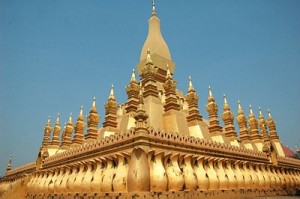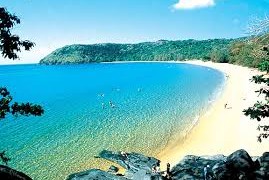Posted in Blog |

Introduction Vientiane is the capital of Laos. Compared to the hectic, bustling capitals in other Southeast Asian countries, Vientiane’s deliciously relaxing atmosphere makes it feel like the small town it is. After you’ve done the round of temples, the best thing to do here has always been to wander down to the riverside, relax with a cold Beerlao – the national beer – and watch the sun set over the Mekong. Of course, the booming tourism industry is changing this by slowly but surely bringing the excesses of Thailand and China to this formerly sleepy city. It has also become famous for bedbugs. Just like any other Southeast Asian capital/major city, Vientiane is experiencing a building boom. Even its Presidential Palace is having a major makeover-addition and a new convention centre has opened recently. History Settled since at least 1000 CE, Vientiane became an important administrative city of the Kingdom of Lan Xang (“million elephants”) in 1545. Ransacked in 1828 by the Siamese, Vientiane experienced a resurgence when it became the capital of the French protectorate, a position it kept after independence 1953, and was unchanged after the communist revolution in 1975. Today Vientiane is the largest city in Laos, with an estimated population of 210,000 in the city itself and some 700,000 in Vientiane Prefecture. Orientation Vientiane is stretched out on the north-eastern bank of a bend in the Mekong River. From the river bank inland, the main roads running parallel to the river are Thanon Fa Ngum, Thanon Setthathirat and Thanon Samsenthai. The central district, Chanthabuli, contains most of Vientiane’s government offices, hotels and restaurants. Vientiane’s widest boulevard, Thanon Lane Xang, runs from the Presidential Palace (now used for government offices and for state receptions) to the northeast around Patuxai, the Victory Gate, towards Pha That Luang, the That Luang Stupa, the most important religious monument in Laos. How to get there By plane Vientiane’s Wattay Airport (IATA: VTE, ICAO: VLVT) is 4 km west of the city. International services are quite limited, but this is slowly changing. International flights There are direct flights to/from: Bangkok Suvarnabhumi: Thai Airways, two flights daily (code share with Lao Airlines) and Lao Airlines, one. Bangkok Aurways also operates one flight daily Hanoi (Viet Nam): Lao Airlines, three times weekly and Vietnam Airlines daily. Ho Chi Minh City (Viet Nam): Vietnam Airlines daily via Phnom Penh; Lao Airlines three times/week via Pakse Kuala Lumpur (Malaysia): AirAsia daily. Phnom Penh (Cambodia): Vietnam Airlines daily. Siem Reap (Cambodia): Lao Airlines three flights weekly via Pakse. Chiang Mai (Thailand): Lao Airlines six times weekly via Luang Prabang. Kunming (Yunnan, West China): China Eastern Airlines operate four and Lao Airlines three flights weekly. Lao Airlines and the Lao Consulate both have offices in the Camellia Hotel, Kunming. Singapore: Lao Airlines flies four times a week on Monday, Wednesday, Friday & Sunday. Domestic flights Lao Airlines...
Read More »
Posted in Blog |

Today, Sapa Travel will show you how to travel Con Dao Island and when to visit Introduction Con Dao islands are a group of 16 islands. The largest island is known as Con Son. Con Dao served as a prison island for political prisoners during the French colonial era, when it was known as Poulo Condore, and in later years the Saigon regime imprisoned opponents of the regime in the infamous cells known as the “tiger cages”. The old prison buildings are still standing and are open to the public as is a small museum tracing the island’s history. Besides having an interesting history, Con Dao is also an island of immense natural beauty with forested hills, deserted sandy beaches and extensive coral reefs making for some excellent diving. Con Dao is another sad example of a National Park doing nothing to preserve the environment, however due its remote and little known location it has been preserved (So far) from the effects of development. 80% of the land area of the archipelago is a National park offering primary jungle teeming with interesting life such as the endemic black squirrel and the crab eating macaque. Beautiful beaches and hidden lagoons are also to be found here, with very few tourists Con Dao is a paradise off the beaten track. For now at least. Most of the surrounding marine are is a no-take marine protected area (MPA). Sadly as in all of Vietnam the national park is a travesty. The national park is in no way responsible for the amazing health of the pristine reefs that surround the islands, home to a large variety of marine life incomparable to anywhere else in Vietnam. Con Cao National Park is currently under going scrutiny of its operations by the World Wildlife Fund and The United Nations Development Program, both groups played a key role in the set up of the National park. Recently funding was withdrawn by another key aid organization DANIDA, as evidence was produced that they were operating in violation of their charter and that the Park was run for personal profit at the expense of the environment. Consider carefully and ask around on the island before using any of the National Park services. International oversight is desperately needed to be sure the environment abuses are halted. Recent reports to the National Park of the spotting of slaughtered turtle shells drying in the sun on the roof of the Anh Dao hotel have produced no inquiry, investigation or prosecution of the hotel. How to get there Con Dao Airport (IATA: VCS) is served by VASCO (a Vietnam Airlines [http://www.firstchoice.vn/vietnam/flights/ ) Flights operated by VASCO (Vietnam Airlines) may be booked at Vietnam Airlines offices or through most tour operators in Saigon. It may be better to book through an official Vietnam Airlines office or through their official website to avoid complications or...
Read More »
Posted in Blog |

Sapa is a beautiful, mountainous town in northern Vietnam along the border with China. Located at 1650 m above sea level in Vietnam’s remote northwest mountains, Sapa is famous for both its fine, rugged scenery and also its rich cultural diversity. Sapa is an incredibly picturesque town that lies in the Hoang Lien Son mountain range near the Chinese border in northwestern Vietnam, known as “the Tonkinese Alps”. Sapa and its surrounding region is host to many hill tribes, as well as rice terraces, lush vegetation, and Fansipan, the highest peak in Vietnam. However, as a result of a recent surge in popularity Sapa has rapidly become a tourist hotspot where money is the new drug of choice. Don’t be put off by the rush, your explorations of the surrounding countryside will be worth the trouble. You can book sapa tours with Sapa Travel office in the town Ethnic Minorities Many ethnic minorities live in and around Sapa. Excluding the Kinh people or ethnic Vietnamese, eight different ethnic minority groups are found in Sapa; H’mong (pronounced Mong), Dao (pronounced Yao), Tay, Giay (pronounced Zai), Muong, Thai, Hoa (ethnic Chinese) and Xa Pho (a denomination of the Phu La minority group). However, the last four groups comprise less than 500 people in total. The population of the district is estimated at 31,652 (1993) of which 52% are H’mong, 25% are Dao, 15% are Kinh, 5% are Tay and 2% are Giay. Around 3,300 people live in Sapa town, the remainder are peasant farmers distributed unevenly throughout the district. Many older women in particular make items such as ethnic-style clothes and blankets, to sell to tourists. Striking up a conversation with them can be very rewarding and their spoken English is impressive. Sadly, however, doing this in Sapa town itself will sometimes lead to a scrum as a multitude of vendors taste a potential sale. Children from these ethnic minorities often begin to support their families financially through selling trinkets to tourists. Do not encourage this by buying from children – Buy from adults. They peddle small metal or silver trinkets, embroidered pillow cases and friendship bands in the main town, and often walk for several hours from their surrounding villages to reach the town. At the end of the day, some take a motorbike ride back to their village, some walk home and some sleep in the market. Girls and boys get married young (around 15-18) and often have two children by the time they are 20 years old. Poverty has led to a great number of girls leaving their villages each day to go selling in Sapa town, and depending on their luck, may only have one meal per day. Weather In winter (the 4 months November to February), the weather in Sapa is invariably cold, wet and foggy (temperatures can drop to freezing and there was snow in...
Read More »







